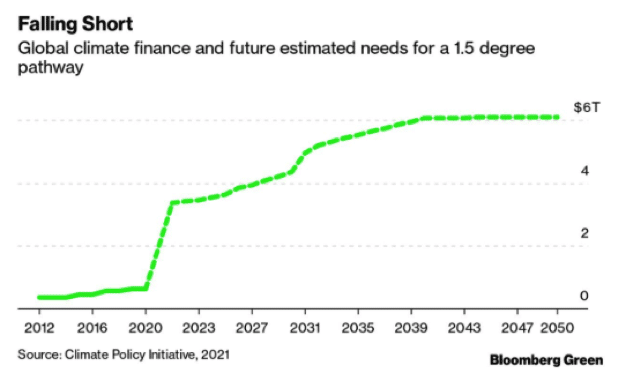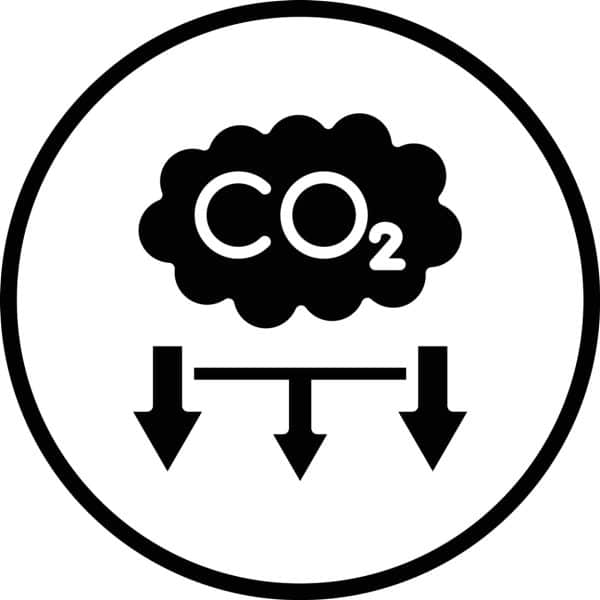Climate economy depends e.g. on Carbon Capture. The following is an extract from a paper from summer 2023:
IPCC's final AR6 report from March 2023 concluded, that global warming is caused by humans in particular from our energy production. This has increased the CO2 level in the atmosphere to more than 418 ppm, far above the ”safe limit” of 350 ppm. IPCC therefore concludes, that drastic and immediate changes must happen to avoid everlasting climate changes to the earth.
Even though climate change investments are increasing they are still far from what is necessary to achieve the COP21 target. In 2023 renewable energy sources e.g. increased by 18% to 500 GW in total for wind, solar, nuclear and geothermic energy production plus energy storage. NetZero however requires an annual increase in this capacity of +1,4 TW before the end of the decade, i.e. a tripling to today.
Fundamentally climate change investments are thus too small. Therefore World Meteorological Organisation (WMO) under UN announced in May 2023, that the chance of reaching the COP21 target was at only 34%. In 2022 that estimate was 52%. The former head of UNFCCC, Chistiana Figueres, claims that there is a lack of commercially viable solutions for at least the next 5 to 7 years. Not only do counties thus invest too little, but technologies also need to be developed.
Carbon capture is necessary
Climate change investments can reduce CO2 emission, i.e. limit the growth of PPM in the atmosphere. But to get the PPM level back towards 350 a large part of the already emitted CO2 must be captured and safely sealed underground again. This capture can take place via natural or artificial methods.
Natural methods particularly include recreating marshlands and forests. So far, 350 mio. hectares, equalling 1/12 of global forest area, has been set aside for this.
- But to reduce the PPM level fast enough, global marsh- and forest area needs to be increase by a third. This is unrealistic as the global population need the areas for farming food. This need will increase, as existing farming areas are destroyed by climate change.
- In addition, re-forestation (BECCS) tends to lead to monoculture forests, that can absorb maximum amounts of CO2 but lead to a drop in biodiversity.
- Planting new trees where there used to be woodland is a zero solution, i.e. does not reduce PPM net, for when a tree dies, it releases the CO2 it has previously absorbed.
- But fundamentally, natural methods are also too slow, cf. IRENA.
There are several main types of artificial CCS
Artificial methods are about capturing CO2 and then seal and deposit it safely. According to IPCC they are necessary, as natural methods cannot be scaled enough, or fast enough.
Carbon sequestration
Carbon sequestration has a promising potential and leans on nature's method for capturing CO2, e.g. in algae. The method involves dispersing a fine powder of rock over farming areas that absorbs CO2 from the air.
- It however needs to be scaled up A LOT AND VERY FAST to impact enough; in all reality it must be compulsory for all farming in developed countries. This again will require facilities for producing rock powder in many countries. This will increase the crop prices. The methods also requires large amounts of energy, i.e. release of CO2, to become reality.
- It is furthermore difficult to document exactly how much CO2 is bound to the rock powder, as this will depend on e.g. moist, temperature, soil composition etc.
CCS/CCUS
CCS (Carbon Capture Storage) means to capture CO2, either directly at the source (chimneys etc.) or through filtering it directly from the air (DAC technologies), and then bind and seal it to a material, and then finally to deposit it underground. There are several main types:
- DAC is seeing a massive investor interest and is e.g. done by swiss company Climeworks on facilities in Iceland. Here the undergroup has porous rock types that allow for CO2 sealing. Other companies include e.g. Equinor, Carbon Cure, Dimensional Energy, BluePlanet and Solidia.
- The method is however costly (2-300 USD/ton) and is globally quite many years out. In 2021 global DAC capacity was at 36 mio. tonnes. In comparison, Denmark emits 61 mio. tonnes a year.
- The scaleability of DAC technologies is therefore a question of CO2 quotas.
- It is however also based on finding other places on the earth with an equalling porous bedrock as in Iceland (and equally cheap electricity to operate the fans). The costs will therefore increase in all other places on earth, because the efficiency will lower.
- Enhanced Oil Recovery, where the oil that is pumped up from the underground is substituted with CO2. The methods increases the efficiency of oil- and gas extraction, in particular with regards to shale gas.
- Environmental organisations have so far opposed the methods from concern that it increases the profitability of oil extraction and thus removes the incentives for oil companies to shift towards renewable energy sources.
- The position may however be softening up, from necessity. In 2023 Denmark e.g. gav permission to TotalEnergies, to capture and store at least 5 mio. tonnes of CO2 every year from 2030 in the Harald oil field (North Sea).
- The weakness of the method is a.o. documenting how well the pumped down CO2 is sealed by the underground, i.e. that it is not re-released to the atmosphere over time.
Carbon capture needs to be climate economic
Common for all methods above is that they do not create income in themselves but rely on large investments and high operating costs. Therefore, all methods are deeply dependent on CO2 quotas and therefore CO2 quota systems are fundamental bottlenecks.
Climate economy therefore requires that CO2 quotas increase substantially.
- Modern DAC facilities can today for instance work on between 94 and 232 USD/tons, when they are scale facilities and when it is in Iceland.
- The EU quota price (ETS) is at 100 USD, and the US subsidy is at 180 USD.
- It is thus more profitable to emit CO2 and then pay for it
Subsidies require documentability ...
In addition the capture methods must document exactly how much CO2 is captured, sealed and stored safely (MRV, i.e. monitoring, reporting and verification).
- This is difficult in practice as some of the largest emitter countries, e.g. China and Russia, have rejected the transparency clauses from the COP21 agreement.
- Because climate is global there is only one number that counts in the end; the PPM level in the atmosphere. If this increases, even though all countries claim to have reached climate neutrality, it means that some countries are not frank or honest. In spite of satellites that monitor general emission of Methane and of CO2, it is in practice difficult to prove who does what and how much. It is thus also difficult to sanction these countries in to complying.
- “Forureneren betaler” princippet virker bedst ved kilden, men er svært at håndhæve bagefter.
- The climate crisis has thus a game theory element. The political will should remain equal across the entire globe, at all time.
... and pre conditionality
Finally they should all fall under the definition of what constitutes eligibility for quota income.
- For over a year, a working group under UN has worked on defining the criteria for when something is CO2 negative. Their definition will thus impact subsidies from both the Inflation Reduction Act and the coming climate compensation funds.
- In june 2023 the group recommended to only include natural methods such as marsh land and forests. The group considered the documentation for CCS technologies to be too diffuse and uncertain.
- Their recommendations thus countered IPCC’s warning that the world needs to capture and store billions of tonnes of CO2 a year using artificial methods.
- IPCC expects Carbon-offset markets to grow from 2 mia. USD today to somewhere between 160 og 624 mia. USD in 2035. According to IPCC this was necessary to increase financial incentives sufficiently.
- The outlook for CO2 quota compensations has been key for attracting investments to CCS technologies.
- After a long warm up, the latter years had finally seen venture momentum towards the simplest CCS, chimneys. This momentum was hoped to affect other CCS technologies, that we still in their financial infancies.
- The US and EU thus both declared their discontent with the conclusions of the UN working group, and their work was stalled.
- The current uncertainty on quota eligibility will dampen the incentive for investments further.
Carbon capture is urgent
The US Energy Information Agency, EIA, has calculated that the US climate goals require CCS of somewhere between 0.4 and 1.8 billion tonnes a year before 2050.
- Wood Mackenzie anslår, that the global need is at least 5 times that of EIA’s estimate, i.e. global capture of 8-9 billion tonnes CO2 a year.
The Carbon capture bottleneck is therefore more potent than the bottleneck for mining (see earlier blog post), because it is long term, structural and irreversible. The climate impact takes many years to change.
- It is EU’s plan to become a global leader in CCS technologies. But current CCS technologies only allow scale up of capacity to around 60 mio. tonnes before 2030. This number corresponds to 0.15 percent of global annual CO2 emissions of app. 40 billion tonnes.
- Chimney technologies (smokestack) are promising but fundamentally they only limit the emission of CO2. They don't capture the CO2 from the atmosphere.
- With the Inflation Reduction Act the US has also joined the race.
- The act involves tax credits of 85 USD per ton CO2 chimney capture and 180 USD using DAC. This is expected to lead to a capture of around 100 mio. tonnes of CO2 a year within 10 years, i.e. 10 times as much as today.
- Et skridt i den rigtige retning, men et meget lille skridt.




